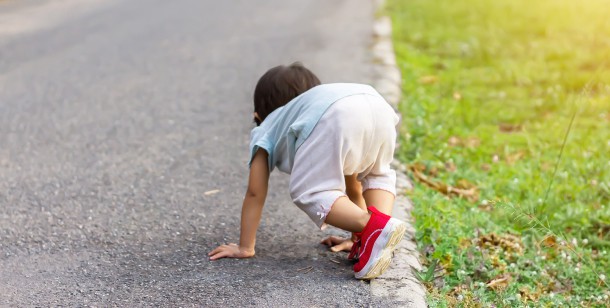When it comes to our children, no injury is small enough not to cause worry. And although head injury in children are common in teens and young children, there is still plenty of cause for concern. A head injury in children can range from minor to life-threatening, and it’s important to have all the facts to ensure that your child gets the care that they need. Keep reading to learn more about common head injuries in children, their causes, and when to seek treatment.

How Do I Know if My Child’s Head Injury is Serious?
Babies fall, athletes take hits, and clumsy kids just trip. But when should you worry about your child’s head injury? If your child takes a hit to the head, cries, or is stunned for a bit, and then resumes play, odds are that they’re fine. But if you notice that your child seems disoriented or experiences pain for an extended period of time, you may have more than a bruise or headache on your hands.
When Should I Worry About My Child Hitting His Head?
If your child has experienced loss of consciousness, has trouble seeing or hearing, or is bleeding excessively from their head, you need to get medical help as soon as possible. Not only can these symptoms be indicative of a more serious problem, but they may be symptoms of a life-threatening injury or condition.

Common Causes of Head Injuries in Children
Children and injuries are like moths to a flame. And as much as you can try to protect them, accidents can always happen. Here are some common causes of head injuries in children:
- Motor vehicle accident
- Bike/skateboard accidents
- Falls
- Sports injuries
- Bullying or child abuse
If a child in your life has consistent head injuries, they may be a victim of physical bullying or child abuse. These types of physical abuse often result in:
- Frequent injuries like black eyes, cuts, or bruises without adequate explanations
- Frequent complaints of pain without obvious injury
- Lack of reaction to pain
- Fear of going home or to school
- Frequently feigned illnesses or excuses to avoid school
- Withdrawn behavior
- Wearing out-of-season clothing to hide injuries on arms or legs
Should you notice any of the aforementioned signs of abuse or have other cause to suspect child abuse, do not hesitate to alert the appropriate authorities, such as child protective services, and find a way to remove the child from the situation if it seems that the child may be in imminent danger.
Types of Head Injuries
Head injury in children fall under two categories: internal and external. Internal injuries involve the skull, brain, blood vessels, and other tissue beneath the skin; external injuries solely affect the skin and scalp. Some external injuries, however, may also cause an underlying internal injury.
Internal Injuries:
Concussion
- A concussion is a mild traumatic brain injury that is caused by a bump or blow to the head or body that causes the brain to bounce or twist inside the skull. They are most commonly seen in athletes but can also be caused by a bad fall, car accident, or other event resulting in a blow to the head. A concussion can cause chemical changes in the brain, with severe cases resulting in stretched or damaged brain cells. Some concussions are only a minor head injury, but can easily become worse if left undiagnosed.
Skull Fracture
- A skull fracture is a break in the skull bone. There are four main types of skull fractures:
- Linear skull fractures
- This is the most common type of skull fracture. These occur when there is a break in the skull bone, but the bone has not been moved. These patients are usually observed in the hospital briefly and are able to resume normal activity in a few days, with a few reasonable restrictions.
- Depressed skull fractures
- This type of fracture occurs when part of the skull bone is sunken in as a result of trauma. Patients with a depressed fracture may require surgical intervention, depending on the severity.
- Diastatic skull fractures
- Diastatic fractures occur along the suture lines in the skull, between the bones in the head that fuse when we are children. These types of injuries are most commonly seen in newborns or older infants.
- Basilar skull fractures
- Basilar skull fractures occur when there is a break in the bone at the base of the skull. This is the most serious type of skull fracture. These patients tend to have intense bruising around their eyes and behind the ears. They may also have a clear fluid draining from the ears or nose. Hospitalization and close monitoring are usually required.
- Linear skull fractures
- A skull fracture is a break in the skull bone. There are four main types of skull fractures:
Intracranial Hematoma (ICH)
- An ICH is a blood clot or bruise in or around the brain. They are classified by their specific location in the brain and can be mild or life-threatening.
External Injuries:
- Broken skin/bleeding
- Burns
- Contusions or bruises
- Superficial cut on the head
When Do Symptoms Appear with Injuries to Head?
Symptoms can present themselves at varying times following an injury, but usually within the first 24 hours at the most. With external injuries, you are more likely to notice an immediate pain response, but those with concussions or an ICH may not notice anything irregular until much later.

What Should You Do If Your Child Hits Their Head?
If your child has lost consciousness, seems disoriented, has dilated pupils, or is vomiting, seek medical help immediately. But should your child seem fine aside from a small bruise, scrape, or bump, treat the external injury accordingly and watch your child. Most of the time, some wound ointment or an ice pack is more than enough to treat a minor injury. Should you notice any strange behavior or troubling symptoms in the coming days, visit your pediatrician or go to an emergency room.
Visit Village Emergency Centers
At Village Emergency Centers, we prioritize our patients’ experiences over everything else. When you bring your child to us, we work hard to make sure they get the immediate treatment they need, with no unexpected costs to you. If you want to learn more about how to handle a head injury in children or need help with any other medical emergency, please do not hesitate to contact us today or visit one of our Houston-area locations!

